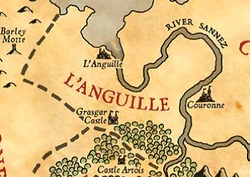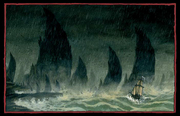"They want to be more Marienburg than we are. I hear that some of the merchants even want to dam the Sannez so they can have their own swamp."
- —Marienburg sailor[1a]
L'Anguille, formally the Dukedom of L'Anguille, is a dukedom of Bretonnia that lies at the northern shores of that kingdom. Known far and wide for having some of the busiest ports in all of Bretonnia, L'Anguille is a rich dukedom that relies heavily on sea-trade for their fortunes. As such, there is a large number of merchants and middle-class commoners amongst the peasant population of the capital. Taubert de L'Anguille is the current Duke of L'Anguille, however his political influence is strongest in the countryside.[1a]
Named after the great fortified port city of Castle L'Anguille, the lands of L'Anguille are beautiful and bountiful. Whilst the shores of other northern lands are wracked with storms and powerful winds, the large cliffs of the L'Anguille prevent this harsh weather from assault the countryside inland, providing the dukedom's farmers opportunities for a bountiful harvest almost all year round. Nestled between the Dukedoms of Lyonesse to the west and Couronne to the east, L'Anguille is considered one of the smallest of the dukedoms of Bretonnia.[1a]
Geography[]
"The salt gets into your brain, you know. That’s why the city folk think about nothing but money."
Most of L'Anguille consists of arable land, though the Forest of Arden covers its southernmost reaches. Despite the fame of the port at Castle L'Anguille, the coastline of the dukedom is actually rather short and famed for being particularly rugged. For most of its length, cliffs plunge straight into the sea, and rocks rise from the water off shore. The currents are even more treacherous than normal; even with a skilled pilot. The sea monsters known as Theralind's Brood that infest the area make things even more hazardous.[1a]

A map of L'Anguille
As a result, there are very few settlements along the coast of L'Anguille, with the notable exception of the great port city of Castle L'Anguille itself. Those who do live there generally want to keep to themselves; hermits, smugglers, pirates, and Chaos Cultists have all been found clinging to the coast. Inland L'Anguille is almost entirely arable, dotted with the castles of the Bretonnian nobility. The soil is fertile and the weather normally mild as if the storms spend all their fury on the sea-cliffs, and few monsters lurk in the fields. The villages of L'Anguille maintain long, narrow strips of woodland, no more than a hundred feet across and often narrower. These bands separate the land of one village from the next, offer a source of timber, provide forage for pigs, and are not large enough to hide bandits or monsters.[1a]
Apart from the great city of L'Anguille, there are no real towns in the dukedom. The cities of L'Anguille and Couronne are so positioned that no area of L'Anguille is very far from them, and they have proved impossible to compete with. On the other hand, it seems as though every village has a weekly market, as no peasant wants to go as far as the cities for daily necessities. The southern stretch of the dukedom is within the Forest of Arden, and Beastmen and fouler things often make their way out of the woods to raid the lands. For some reason, stagheaded Beastmen are particularly common in this dukedom.[1a]
Notable Locations[]
Dragon's Maw[]
The Dragon's Maw s an area of the L'Anguille coast a day's travel from the border with Lyonesse. Dozens of sharp rocks rise from the water, and the tides and currents raise a constant spray from them, so that they look like teeth wreathed in smoke. This is also the area most often hit by storms, with at least one major storm striking every week. Sailors believe entering the area is certain death, but they have no superstitions: the natural features are quite dangerous enough.[1a]

A ship travelling through the treacherous Dragon's Maw
However, traders have noticed that people travelling by land within a few miles of the area also disappear. Indeed, no one reliable has seen the area at all for over three years, and those who have gone to look have not come back. The Duke will do nothing, as it is on the coast, and the local lord is (now) a ten year-old boy. He will offer almost anything to adventurers who can bring his father back.[1a]
Inhabitants[]
"If you see the same few people every day for years, you stop believing that anyone else exists, and you really think that the size of your cow is a measure of your importance."
The people of L'Anguille fall into two groups: those from the great port city of the same name and those from the rural countryside. They differ radically in culture, and rivalries between them are as strong as the local rivalries with other dukedoms. Those from the city are sailors, fishermen, and merchants. They make their livelihoods from the sea and are proud of it. For them, true courage is to be found in the face of the elements, whilst the time on shore is an opportunity to enjoy life as much as possible. They claim the country-folk spend so much time worrying about next year's crop that they forget to live. People leave the city to settle down or because they want to face challenges that can be defeated, rather than merely survived.[1a]
Those from L'Anguille's countryside are peasant farmers. They are solid and reliable, and the main threats they face are from bandits and, especially, Beastmen. They claim the city folk are gamblers who cannot be trusted to do an honest day's work. People leave the country to see something more exciting than a turnip harvest or to take the fight to the Beastmen. The tension between the two groups is the main factor in the internal politics of the dukedom. Duke Taubert's avoidance of the sea exacerbated this; not only does he never visit the city of L'Anguille, but he also avoids thinking about it as much as possible. He has appointed several stewards upon the port, but previous ones all failed to impose order. The current steward of L'Anguille, Godemar Fitzgodric, is the wealthiest merchant in Bretonnia, head of the Brethren of the Lighthouse, a cabal of wealthy merchants who control politics in Castle L'Anguille, and fully effective in making sure that the city's taxes are paid on time.[1a]
Godemar and the Brethren of the Lighthouse, however, want independence from the duke and true sovereignty over their city. Godemar, as a man of peasant stock, is a very lowly servant of the duke -- a fact the duke's court rubs his nose in every time he goes to pay the city's taxes. However, his position has allowed him to bring the city almost entirely under the control of the Brethren of the Lighthouse. The Council of the Brethren are currently debating their next move: should they seek independence from the Dukedom of L'Anguille, or independence from Bretonnia itself with the lands of the dukedom dependent on them? Whilst this debate continues, they are interested mainly in maintaining political stability, which is always best for business.[1a]
Duke Taubert's absence from the port means he is unknown to most people in the city. There are some who are considering appealing to him about the abuses of the Brethren of the Lighthouse, and among them, he has an almost messianic reputation. Most citizens of L'Anguille, particularly merchants, regard him as distant and ineffectual, and that's the way they like it.[1a]
Among the peasantry of the dukedom's countryside, things are very different. To them, the Duke of L'Anguille is a hero, riding personally against the Beastmen. He has set up a chain of signal towers along the edges of the forest which relay an alarm to Grasgar Castle if raiding bands are sighted. Armed bands are sent out in response, often led by the duke in person. More than a few villages have been saved from utter destruction by the timely arrival of the duke's men-at-arms, and there are some people who have had their lives saved by him personally; this, naturally, often has a major impact on their opinions of their duke.[1a]
Beastmen[]
The unique stag-headed beastmen are also prevalent in the Dukedom and have become more cunning over the years. The more brutish have simply turned their attentions to Lyonesse, Artois, and Couronne. This is the cause of some tension with the neighboring dukedoms, and some of the other nobles mutter that Duke Taubert should try to defeat the Beastmen properly rather than just driving them into other lords' lands. The fact remains, however, that Duke Taubert is acting more heroically than are most other lords in the area, and this keeps criticism muted whilst making it more likely that he will be opposed on other issues.[1a]
Theralind's Brood[]
The sea monsters known as Theralind's Brood are common along the coasts of L'Anguille. They are scaly with a somewhat horse-like head fitted with fangs. They will eagerly attack fishing boats and even larger ships sometimes. They leap from the water onto the deck of a ship and are just as viscous on land in water. Some believe that they are an adult version of a carnivorous fish found in the Rive Sannez.[1a]
Settlements[]
- Castle L'Anguille - Dominating the trade of northern Bretonnia, Castle L'Anguille is the largest and most important city in the dukedom.
- Ora Lamae - Containing a small castle and not much else, this tiny settlement is on the border of old Mousillon.
- Serrac - This settlement is home to about three hundred peasants.
- Grasgar Castle - This newly renovated lodge has now become a massive keep and the headquarters for the current duke.
Notable L'Anguillians[]
- Taubert de L'Anguille - Taubert de L'Anguille is the current Duke of L'Anguille.
- Corduin - Corduin is one of the mighty Grail Companions and was the very first Duke of L'Anguille.
- Rodrik de L'Anguille - Rodrik de L'Anguille is famed for being the lone survivor of a failed expedition to Lustria.
- Balderin Beastslayer - Balderin Beastslayer was a Bretonnian hero and lord who fought during the historic Siege of L'Anguille.
